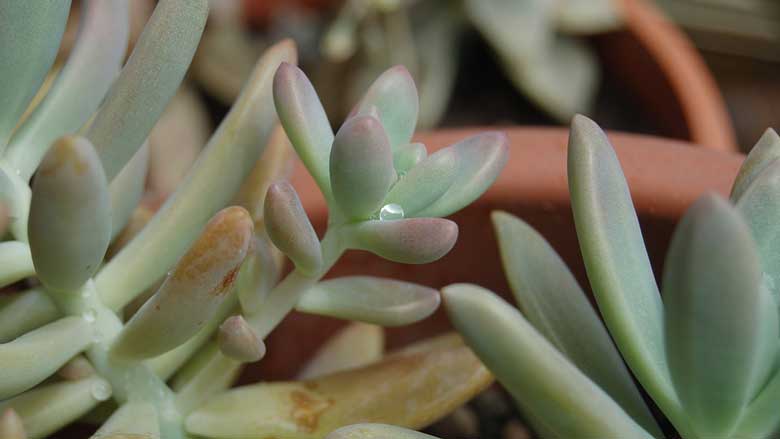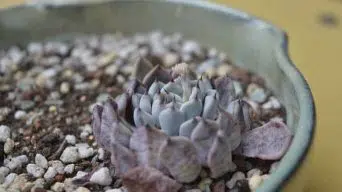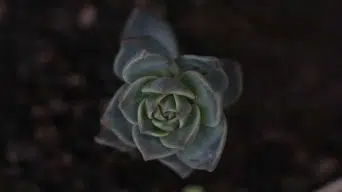Succulents are plants that store water in their leaves, stems, or roots. They often have thick fleshy leaves, which can be either light or dark green in color.
Succulents come from sunny places like deserts and mountain sides where they grow without too much rain.
Etiolated succulents are usually caused by insufficient sunlight exposure to the plant’s leaves, causing them to appear pale and thin.
The main goal of this blog post is to provide information on etiolated succulents so you can recognize, treat and prevent them if possible!
What is Succulent Etiolation
Etiolation is a very common problem with succulent plants.
The word etiolate comes from the Greek word etiology, which refers to an abnormal or misdirected biological development. In this case, the plant’s stem or leaves become long and thin due to a lack of light exposure.
The stem or leaves of the succulent plant become long and thin, pale in color, and weak. The term etiolation is also used when describing seedlings that have been grown under low light conditions for a prolonged period.
In nature, plants use photosynthesis to produce food from sunlight by taking carbon dioxide out of the air and water from the soil, creating sugars stored as starches in their tissues.
When a plant does not get enough direct sunlight, it begins to elongate to reach the light.
This is good for its survival when it’s outside where there are many variables at play, but not so great when you’re trying to grow a plant indoors without sufficient lighting.
Homegrown succulents and houseplants need direct sunlight (or strong artificial lights) to thrive and produce beautiful flowers and fruit like the ones we see on cacti in nature.
When they don’t get enough natural or artificial light, their stems begin to stretch out looking pale because chlorophyll synthesis fails under low-light conditions. This causes them to become weak, elongated (etiolated), deformed, and vulnerable to diseases such as rot which can kill entire plants if left untreated.
Is Succulent Etiolation Bad?
Etiolation is not always bad. Etiolation is not a disease in itself, but it can be caused by an underlying problem with the plant. In some succulents, etiolation is a natural stress response, and it may not cause any issues.
In other plants, however, this phenomenon can be a sign of an underlying problem with the plant’s root system or stem structure that needs treatment at once before the condition worsens.
Usually, if a succulent looks etiolated, it results from too little light or extreme heat.
In most cases, you can treat an etiolated plant by providing additional lighting and keeping the soil moist but not wet. In some more severe cases, however, with an etiolated cactus that has been severely stressed from lack of water, you may need to do a plant surgery and cut away the affected parts of the stem.
Generally, etiolation is not dangerous in itself, but it can indicate that something else is wrong with your succulents.
If your succulent looks severely stressed from lack of light or heat, for instance, this could indicate an underlying problem such as root rot from being overwatered.
If a succulent is not getting sufficient light, the etiolated stem may eventually become so weak that it breaks off and can no longer be saved.
In some cases, you might notice etiolation on only one part of your plant or in just a few branches while other parts look healthy.
This can be a sign that the plant’s growth pattern has been disrupted for some reason. Perhaps, your succulent is growing in an area with too little light or heat, and it started to stretch out its stem towards more sunlight.
The etiolated parts of the plant may eventually start dying back until they are no longer attached to the main body of the plant and the entire succulent dies.
In most cases, this is not a significant problem, as etiolated stems can easily be removed from the plant without harming it.
However, if your succulent stem has become too thin or brittle to remove by hand (e.g., cacti), you may need to perform surgery on the plant and cut the stem away.
What Causes Succulent Etiolation
A lack of light typically causes etiolated succulents. This occurs when a succulent is placed in an area with low light levels or receives too much shade.
The lack of adequate sunlight causes the leaves to stretch out and become weak, spindly, and pale-colored. If you notice that the leaves of your succulents are pale and thin, they may be suffering from etiolation.
Also, etiolated succulents tend to become leggy. If you notice your stretched succulent growing tall with few leaves, it may be trying to get more bright light.
The reason why legginess happens is that your plant isn’t receiving enough light, so its growth hormones aren’t being produced at optimal levels, which causes stem extension instead.
A similar thing may occur on plants grown indoors near windows facing north where they don’t receive full sun all day long but do get some early morning or late afternoon sun.
In this case, the plant keeps growing and never stops because it’s receiving light when its hormones are being produced, which causes stem extension instead of leaf production.
In addition to etiolation due to lack of light, succulents can also become leggy if exposed to too much heat or cold for extended periods.
This typically only occurs in outdoor plants that have been exposed to unusually high or low temperatures throughout their dormancy period during fall/winter months, so they don’t experience enough chill hours required for proper growth cycle completion before entering summer dormancy again.
How to Recognize Etiolation in Succulents
Etiolated succulents are characterized by long, weak stems that grow tall and stretch out.
A new stem can be seen growing from the center of each rosette. Leaves become skinny or spindly and appear more spread out than they usually would.
When a succulent is suffering from etiolation, its growth results in rosettes with longer spaces between leaves (internodes) where the stem has extended further to reach toward the light source.
The plant’s stems may also become weak or break easily when it reaches for more sunlight.
In addition, succulents with etiolated symptoms may experience a loss of color and appear more pale than they normally do.
This is because the plant’s stem is extending to try and reach for sunlight, but it still lacks chlorophyll that would give them their full-green pigment or coloration.
Common Signs of Etiolated Succulents
1. Weak and Spindly Growth
This is the most common sign of an etiolated succulent. The stems will be thin and not very bright green.
They might only have a few leaves or even no leaves at all.
The weak stems cannot support the weight of the succulent, and you will often find it sprawled out on its side or upside down.
2. Long Internodes
The length between the leaves of etiolated succulents will be longer than usual.
The stems are stretched out because they have to find light on their own instead of being supported by other plants or objects nearby.
This can also cause leggy growth, which makes your plant look even spindlier and weaker.
3. Curling Upwards
The ends of the leaves curl upwards. This is caused by your succulent growing towards the light (and away from shade).
The curling will also create a sort of “cup” shape at the end of each leaf because it’s trying to follow all available light that might be coming through windows, skylights, or glass doors.
4. Drooping
Another sign of an etiolated succulent is drooping. The whole plant will be weak and unable to support itself, so that it will droop over the sides of pots and containers.
This can also cause your succulent to look like it’s melting or wilting even though you water it regularly and keep its soil moist.
5. Leaves Curling Down
Etiolated succulent leaves will begin to curl downwards.
Succulent leaves begin to curl down and droop when light is blocked from reaching the lower parts of your plant.
This can be caused by other succulents or plants growing too close to your plant and shading it from the sunlight.
5. Pale or Yellow Leaves
Another sign of etiolated succulents is pale or yellow leaves. Your plant isn’t getting enough light, and it will begin to lose its natural vibrant green color.
The lower part of your plants might even turn a grayish-brown color which can be alarming and indicate that something needs to change if you want the plant to begin thriving again.
How To Fix Etiolated Succulents
When succulents begin to etiolate, there are several things you can do to help them recover. Although succulents do grow very slowly, they can still be salvaged if you catch the problem early.
However, if your succulent is already stretched out and looking long and spindly, you can help it recover its health, but it will never look the same again.
When succulents become etiolated, there are several things you should do to help them recover:
Increase Sun Exposure Gradually
One of the most important things you can do to help your succulent is gradually getting them accustomed to more sun exposure.
Some signs that your succulents need more sunlight are leggy plants, crispy leaves, and very little new healthy growth or blooms. Succulents that have recently been repotted may also need more sunlight.
The most important thing about increasing your plant’s exposure to the sun is not doing it too quickly and causing succulents to sunburn or damage.
If you live in a hot area, try putting your plants outside for an hour during the morning when temperatures are cooler so they can get used to direct sunlight gradually.
Move them into the sun a little more each day or every other day until they are outside all day.
If you live in an area with no intense heat, your succulents can probably take full sun exposure right away without any problems.
Just be sure to move them into direct sunlight over several days gradually so they don’t get burned and scorched.
Prune off Spindly Growth
If you notice that your succulent is growing spindly and leggy, prune off the weak stems.
Pruning will encourage new growth to come out of healthier areas on the plant rather than just more long shoots trying to reach sunlight.
Succulents can also be pruned back to help them recover and rejuvenate.
If you notice that your succulents are becoming leggy from long shoots stretching toward the sun, try cutting those stems off as low as possible with sharp shears or scissors.
In most cases, you should be able to cut right above a leaf node (the place where leaves join the plant’s stem).
This will encourage new growth to come out of that node, and your succulent won’t have to stretch toward the sun anymore.
How To Prevent Etiolation in Succulents
Now that you know how to recognize etiolation and help your succulents recover from it, here are some tips on how to prevent the condition in the first place:
Provide Ample Sunlight
The most important thing is providing enough sunlight for your plants. If you live in an area where there isn’t a lot of intense sunlight, use artificial light instead.
Be sure to move your plants into more intense sunlight gradually over several days so they don’t get sunburned or stressed out by the change in exposure.
Repot Succulents at the Right Time of Year
This is especially important if you live in a colder region where succulent growth slows down or stops during winter.
Generally, you should wait to repot succulents until after they have begun actively growing in early spring when the weather starts to warm up a bit.
If your plants aren’t growing very much during late summer and fall, it might be time for a bigger pot too!
Give Succulents a Bigger Pot if Necessary
If you notice that your succulents are becoming leggy and long, it might be time to move them up to a bigger pot.
This will encourage the plants to grow thicker stems that won’t stretch toward the light nearly as much.
Rotate Pots Every Once in a While
This will help your succulents grow the same way every time they are exposed to sunlight.
If you notice that your plants tend to lean toward one side, turn their pots or move them around from time to time so they don’t have as much of an advantage over other sides where leaves and stems can stretch.
Prune Succulents to Encourage Fuller Growth
If you notice that your succulents are growing spindly and leggy, prune off the weak stems.
Pruning will encourage new growth to come out of healthier areas on the plant rather than just more long shoots which are trying to reach sunlight.
Final Thoughts
Succulent etiolation is a common problem that can cause severe damage to your plants.
The main reason for etiolation in succulent stems is the lack of sunlight.
When growing succulents, the best way to prevent etiolated succulents is by providing your plants with enough sunlight, but not too much.
As long as your plants are enjoying their time outdoors, etiolation should not be a big problem.
If you do spot some symptoms of an etiolated succulent on your plant or collection, make sure to treat it immediately and know how to recognize the signs!







